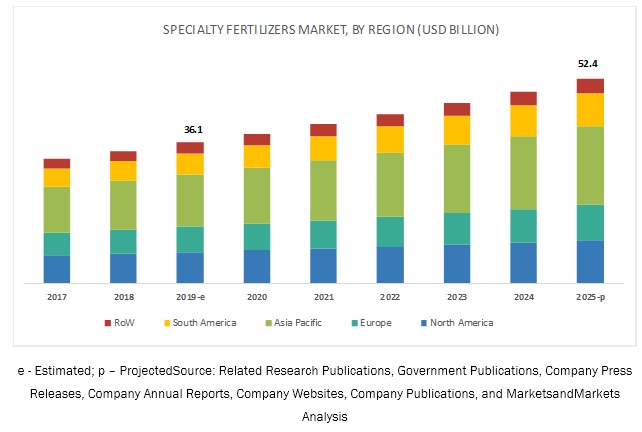The report “Specialty Fertilizers Market by Type (UAN, CAN, MAP, Potassium Sulfate, and Potassium Nitrate), Application Method (Soil, Foliar, and Fertigation), Form (Dry and Liquid), Crop Type, Technology, and Region – Global Forecast to 2025″ The global specialty fertilizers market is estimated to be valued at USD 36.1 billion in 2019 and is projected to reach a value of USD 52.4 billion by 2025, growing at a CAGR of 6.4% during the forecast period. Factors such as the rise in demand for high-efficiency fertilizers and an increase in crop varieties are projected to drive the growth of the specialty fertilizers market.
Report Objectives:
- To define, segment, and project the global market size of the specialty fertilizers market.
- To understand the specialty fertilizers market by identifying its various subsegments
- To provide detailed information about the key factors influencing the growth of the market (drivers, restraints, opportunities, and industry-specific challenges)
- To project the size of the market and its submarkets, in terms of value, with respect to the regions (along with their respective key countries)
- To profile the key players and comprehensively analyze their core competencies.

Download PDF Brochure:
https://www.marketsandmarkets.com/pdfdownloadNew.asp?id=57479139
The fertigation segment is estimated to account for the largest market share, in terms of value, in 2019.
Fertigation is used in the fields of row crops, horticultural crops, fruit crops, vegetable crops, and ornamental & flowering crops. The fertigation method allows the homogenous application of liquid specialty fertilizers in an adequate amount to the wetted zone in the root development, where most of the active roots are concentrated, which helps in enhancing the efficiency of specialty fertilizers. This technique allows specialty fertilizers to be distributed evenly in irrigation. The application of specialty fertilizers through fertigation increases its efficiency by 10%–15%, as compared to conventional fertilization.
The coated & encapsulated segment is projected to witness the fastest growth, in terms of value, in the specialty fertilizers market, on the basis of technology, from 2017 to 2025.
Coated & encapsulated specialty fertilizers are conventional soluble fertilizer materials with increasingly available nutrients, which after granulation, prilling, or crystallization, are given a protective (water-insoluble) coating to control the water penetration, thereby affecting the rate of dissolution and the nutrient release. To further reduce the total fertilizer costs, coated & encapsulated fertilizers are increasingly used with the blend of conventional fertilizers in different ratios. These fertilizers offer greater flexibility in determining the nutrient release pattern.
The increasing demand for various crops in the Asia Pacific regions is driving the growth of the specialty fertilizers market.
The increasing agricultural practices and requirement of high-quality agricultural produce are factors that are projected to drive the nitrogenous fertilizers market growth in this region. Major crops produced in Asia include rice, sugar beet, fruits & vegetables, cereals, and grains; the region consumes 90% of the global rice produced. Asian countries, such as Korea, China, Japan, and recently Vietnam, are applying high levels of nitrogenous fertilizers per hectare for both short-term and perennial crops. Hence, the demand for specialty fertilizers is high in the region.
Make an Inquiry:
https://www.marketsandmarkets.com/Enquiry_Before_BuyingNew.asp?id=57479139
Key players in this market include Nutrien, Ltd. (Canada), Yara International ASA (Norway), Israel Chemical Ltd. (Israel), K+S Aktiengesellschaft (Germany), Sociedad Química y Minera de Chile (SQM) (Chile), The Mosaic Company (US), and EuroChem Group (Switzerland). These major players in this market are focusing on increasing their presence through expansions & investments, mergers & acquisitions, partnerships, joint ventures, and agreements. These companies have a strong presence in North America, Asia Pacific, and Europe. They also have manufacturing facilities, along with strong distribution networks across these regions.